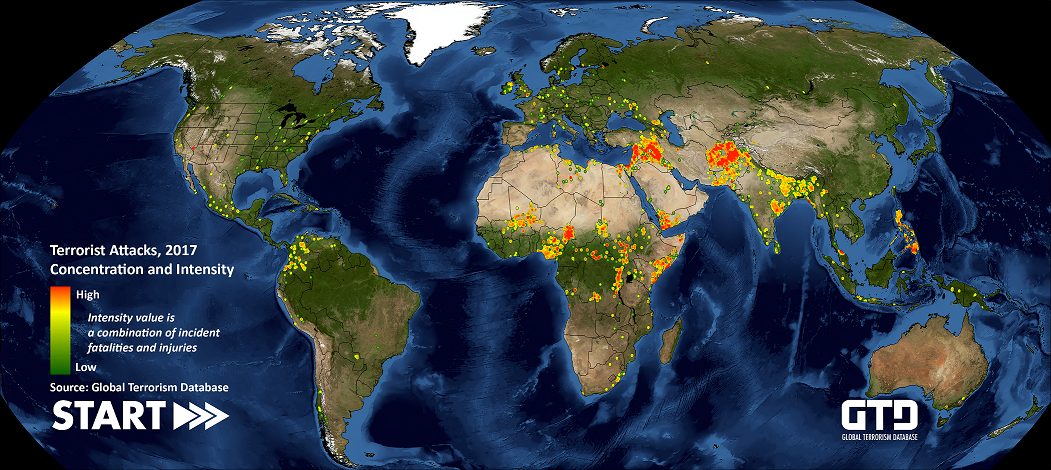With 10,900 terrorist attacks killing more than 26,400 people in 2017, the numbers of terrorist attacks and deaths worldwide have declined for the third consecutive year, according to new data released today by the University of Maryland’s National Consortium for the Study of Terrorism and Responses to Terrorism (START). A background report provides an overview of the new 2017 data in START’s Global Terrorism Database, which now includes information on more than 180,000 terrorist attacks that have occurred worldwide since 1970. The data is made available to the public and can be downloaded at www.start.umd.edu/gtd.
Despite recent decreases in terrorist violence, the number of attacks in 2017 is 28 percent higher than in 2012, and deaths 71 percent higher. Terrorist violence peaked in 2014 at nearly 17,000 attacks and more than 45,000 total deaths.
“While three consecutive years of decreases is encouraging, terrorist violence remains extraordinarily high compared to historical trends,” said Dr. Erin Miller, GTD program manager. “In the decade prior to the September 11th attacks, the frequency and lethality of terrorist violence worldwide each year was less than one-third of what we saw last year.”
In 2017, terrorist violence remained heavily concentrated in certain locations, and coincided with other types of political violence. More than half of all attacks took place in four countries: Iraq (23%), Afghanistan (13%), India (9%) and Pakistan (7%). More than half of all deaths took place in three countries: Iraq (24%), Afghanistan (23%) and Syria (8%).
The deadliest terrorist attack in 2017 took place in October, in Mogadishu, Somalia. Assailants detonated explosives in a truck near the Safari Hotel. More than 580 people were killed, and more than 300 others were injured.
The Islamic State of Iraq and the Levant (ISIL) was responsible for the most terrorist attacks (1,321) and deaths (7,120) in 2017, though were responsible for 10 percent fewer attacks and 40 percent fewer deaths than in 2016. The Taliban and al-Shabaab were the next most active with 907 attacks (4,925 deaths) and 573 attacks (1894 deaths) respectively.
In the United States, there were 65 terrorist attacks in 2017, compared to 64 in 2016. However, terrorist attacks in the United States killed 91 victims in 2017, a 49 percent increase compared to the number of victim deaths in 2016. There were 17 lethal terrorist attacks in the United States in 2017, compared to six in 2016. The deadliest attack in the United States took place in October, in Las Vegas, where an anti-government extremist shot and killed 58 people attending a music festival, and wounded more than 850 others. Also in October, an assailant inspired by the Islamic State drove a rental truck into people on a bike path for approximately one mile in New York City. The attack killed eight people, including several tourists, and injured at least 12 others.
“Given the inherently political and emotional nature of terrorism, there is no substitute for objective and transparent data as a basis for counterterrorism policy and practice,” said William Braniff, START director. “We are proud of the contribution that the Global Terrorism Database makes, as well as our other datasets, to empower rigorous analysis and decision-making in such an important area of international security.”
Based at the University of Maryland, the Global Terrorism Database received funding for the 2017 data collection from the U.S. Department of State and the U.S. Department of Homeland Security.
